The biggest event in badminton is upon us once again, and the first time since the pandemic that spectators are allowed back on the venues.
As usual, there are plenty of expert predictions on who’ll claim the medals. I don’t feel I have anything meaningful to contribute in that regard, so instead I thought I’d dive into the participating players’ badminton shoes and rackets used to see if we can learn something.
I’ve spent a ton of hours researching and gathering the data for this as the brand websites and catalogs aren’t always updated and easy to navigate. I’d like to send a shoutout to CK who has interviewed a bunch of players about their gear which made this task easier (check out his channel via the link above if you’re curious about badminton gear).
That doesn’t mean that this is perfect, though. There are a portion of players whose gear I wasn’t able to confirm — usually because they don’t participate in the World Tour regularly so there isn’t that much recent footage of their games or marketing material available sharing their gear.
In a few rare cases, you’ll notice players use an old edition of gear or are mixing brands. This isn’t a mistake, but I won’t be diving into why each of their situations are unique. Most notably Chinese men’s singles player Shi Yu Qi, who appears to be sponsored by Yonex officially, but plays with Li-Ning shoes.
The Olympics haven’t begun at the time of publishing this, so this data is based on what gear the players have been using during recent interviews, match footage, social media posts, or something similar.
Since we know that it takes a while to get used to new gear and that this is the biggest ‘regular’ badminton event, it’s highly unlikely that players would switch to new gear just before the Olympics at the risk of lowering the quality of their game. So we can assume that they’re likely still playing with the same gear.
Finally, keep in mind that loads of top badminton players on the World Tour aren’t participating in the Olympics due to the limited number of players each country is allowed to bring.
Update: as I was about to publish this, the French men’s doubles pair Christo and Toma Popov was offered a wildcard to participate as an extra pair, which means they aren’t included in the stats. This won’t change the data much, but I thought it was fair to let you know.
With that in mind, let’s dive in.
Table of Contents
The most used badminton gear during the 2024 Olympics
Let’s begin with a few fun statistics.
Yonex is by far the brand with the most sponsored players participating in the Olympics, and it isn’t even close!
A whopping 71% of the 176 badminton players are sponsored by Yonex as an individual player (not considering team/country sponsorships as those can be different from the individual sponsor). In comparison, the two other popular badminton brands Victor and Li-Ning only cover 8% of the players each.
The remaining 13% of players were sponsored by brands like Babolat, Flypower, Apacs, and others, with two percent that I was unable to confirm.
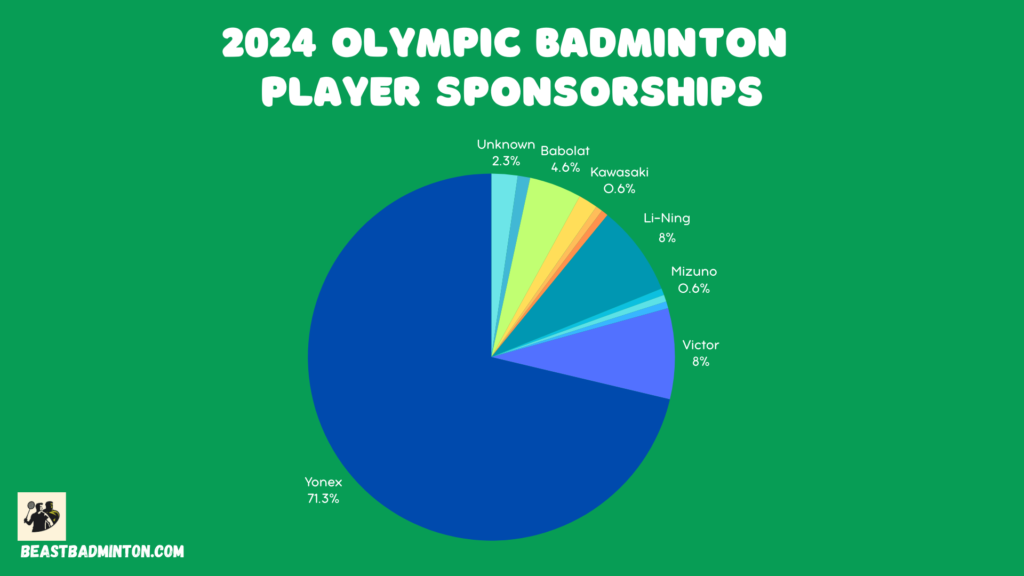
If we break that down by each match category (men’s singles, mixed doubles, etc.), Yonex sponsored between 56%-84% of the players in each category, with men’s singles being the one where Yonex has the lowest representation and where the highest number of different brands compete (seven in total).
Victor and Li-Ning sponsor about the same number of players across all five categories, except I didn’t notice Li-Ning sponsoring any women’s doubles players. I figure that might come down to who they’re able to make a deal with.
Moving on to fun geographical data, let’s break down in which areas of the world the brands are most represented.
Africa + the Middle East are sparsely participating with 5% of the players, while the Americas make up 10%. As I’m sure it’s no surprise, Asia + Oceania and Europe contribute 59% and 26% of the players respectively. Besides a few players here and there, the majority in Africa, the Middle East, and the Americas are sponsored by Yonex with no presence from Victor or Li-Ning.
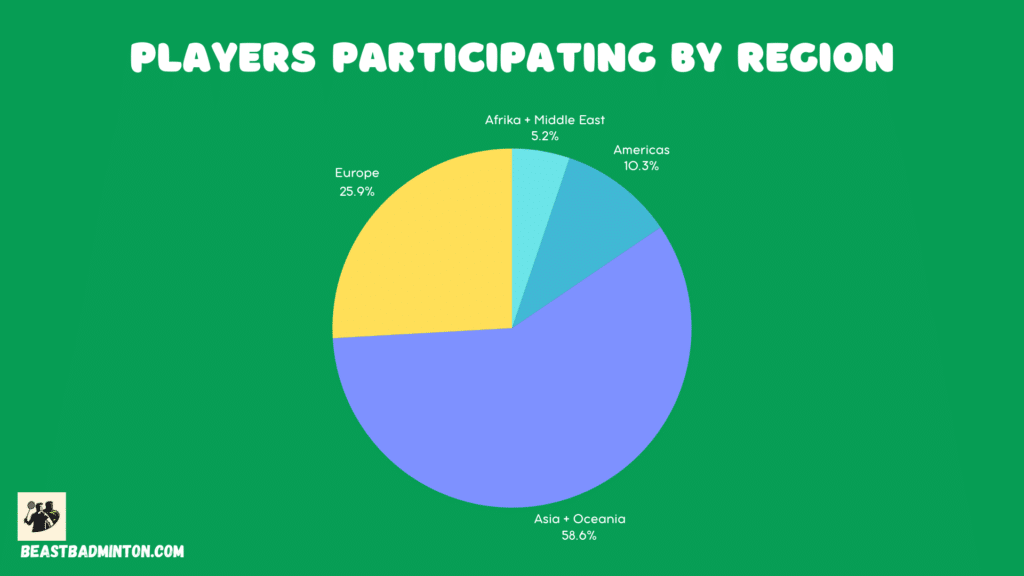
In Asia and Oceania, Yonex covers nearly 3/4 of the players and 2/3 in Europe, and this is where we’ll begin to notice a distinction. Whereas Li-Ning and Victor sponsor 12% and 11% of the players in Asia respectively, they only cover 4% (Li-Ning) and 7% (Victor) in Europe.
Flypower sponsors as many players as Victor in Europe at this Olympics, but second place goes to Babolat sponsoring 11% of the European players.
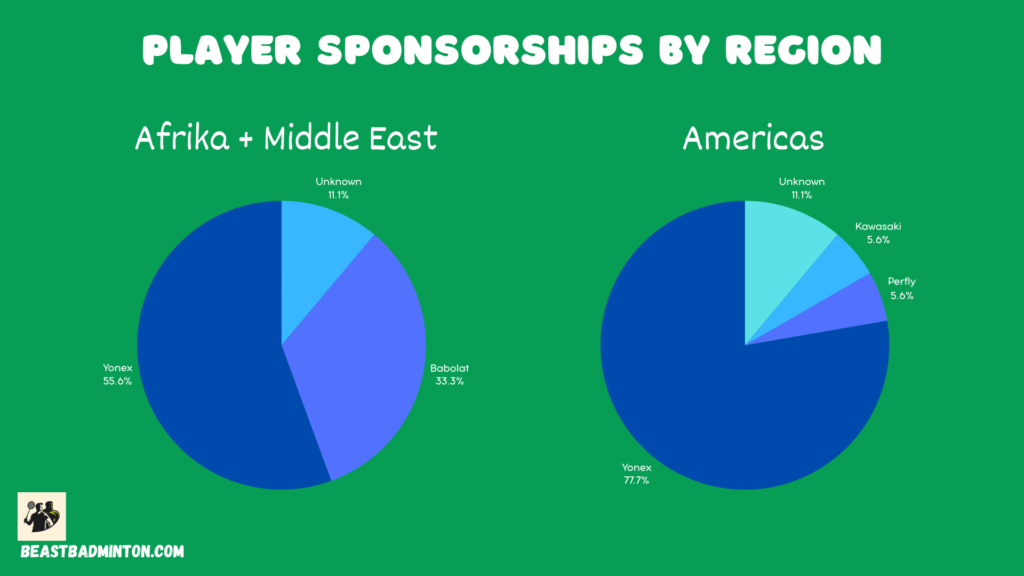
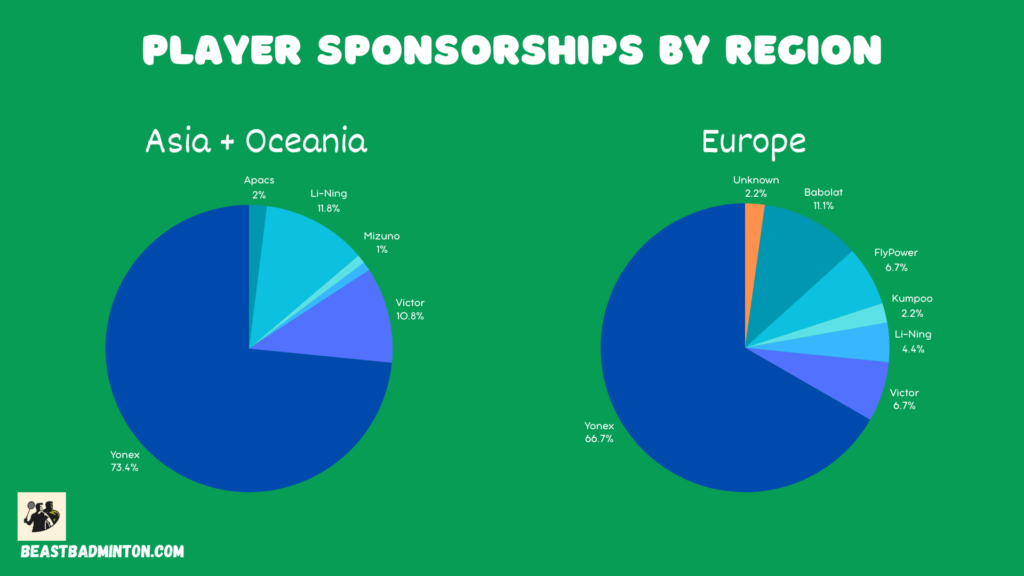
Now that we’ve confirmed what many of us were already thinking, let’s look at what kind of badminton shoes are most popular at the Paris 2024 Olympics before diving into rackets.
The most popular badminton shoes
To my surprise, I noticed several players who have other sponsors but still play in the Yonex SHB 65z3 badminton shoe, making it the most popular shoe by far with 52% of all the players using it (check out the review via the link above).
Crazy.
As a reference point, the next popular shoe is Yonex’s Aerus Z2 used by 7% of the players, while I couldn’t confirm which shoe model was used by 7.5% of the players. In total, I counted 27 unique shoe models used, many of which I’ve tested in my badminton shoe reviews.
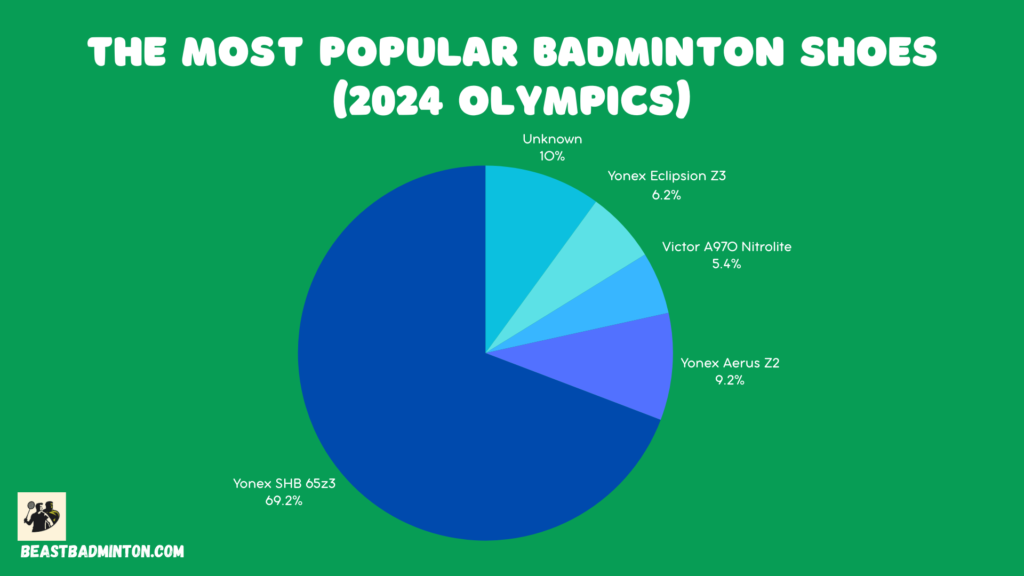
70% of the players prefer all-around shoes (based on the weight), whereas 9% preferred something more lightweight and 13% preferred supportive shoes. The most popular shoe category across all regions was the all around category, which isn’t surprising as there are so many options leaning both towards speed or support.
Diving into the all around badminton shoe category, a few models stood out. The reason I’ve included seven is that the 3rd and 4th spots were even between two pairs.
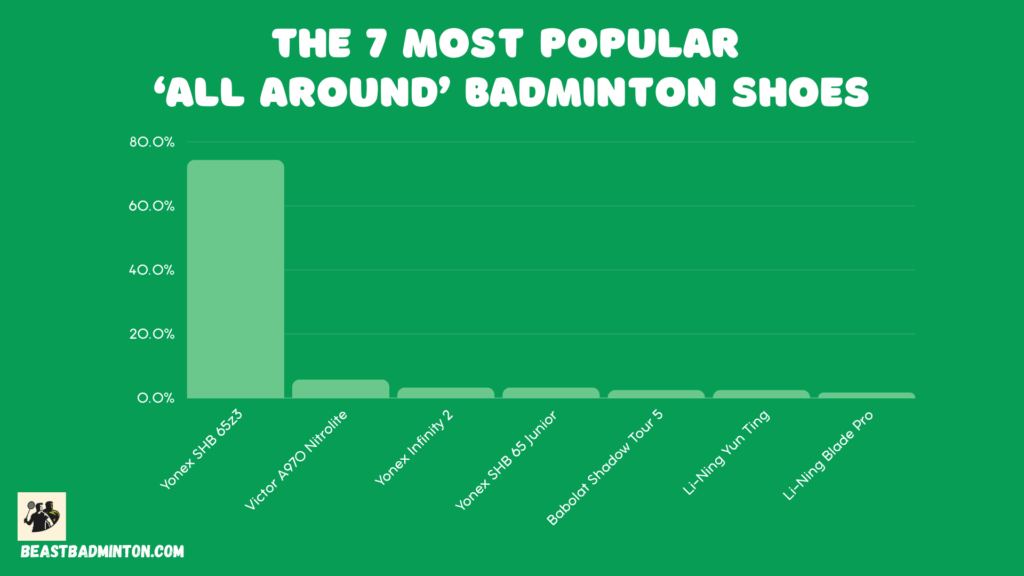
The most popular badminton rackets
Rackets are trickier for me to identify during game footage, leading to 19.5% of them being unconfirmed as there are more options available compared to shoes. In fact, I spotted 45 different badminton rackets used among the 174 players participating in the 2024 Olympics.
Viktor Axelsen’s Yonex Astrox 100ZZ was the most popular one with 8%, followed by Yonex’s Nanoflare 700 (8%), the Arcsaber 11 Pro (7%), Astrox 88D Pro (6%), Astrox 77 Pro (6%) and Astrox 88S Pro (5%).
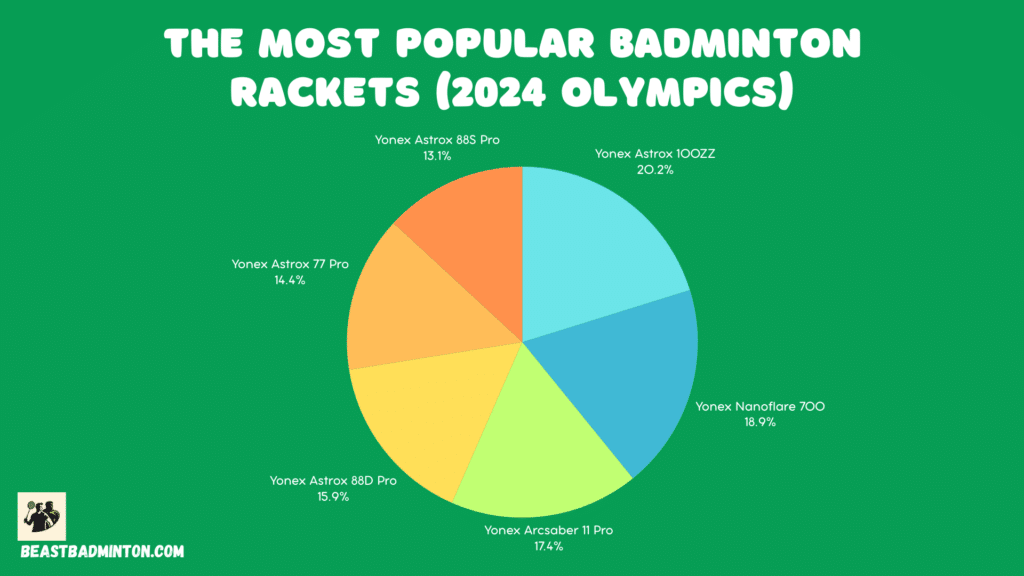
If you’re looking to pick up some of these rackets yourself, I’ve tested the intermediate editions of several of them: Yonex Astrox 100 Game, Arcsaber 11 Play, Astrox 77 Pro, Astrox 77 Play (for beginners), Astrox 88D Game (2nd edition), and the brand new Astrox 88S Game 3rd edition.
That gives us a hint of just how much variety there is across all brands when it comes to rackets, not just Yonex. The racket choices among Li-Ning and Victor sponsored players were more varied, which could be due to both brands recently launching several top-tier variations of the same rackets (i.e. Victor’s Thruster Ryuga II, Ryuga II Pro, Ryuga Metallic), whereas Yonex tends to release one top tier edition per racket series along with editions for beginners and intermediate players.
It should come as no surprise that the power beast that is the Astrox 100ZZ is the most popular racket among men’s singles players with 12% of the players preferring it (this might be slightly skewed as I struggled to identify 27% of the men’s singles player rackets – most of them being from smaller nations that don’t often appear during regular top badminton events, though).
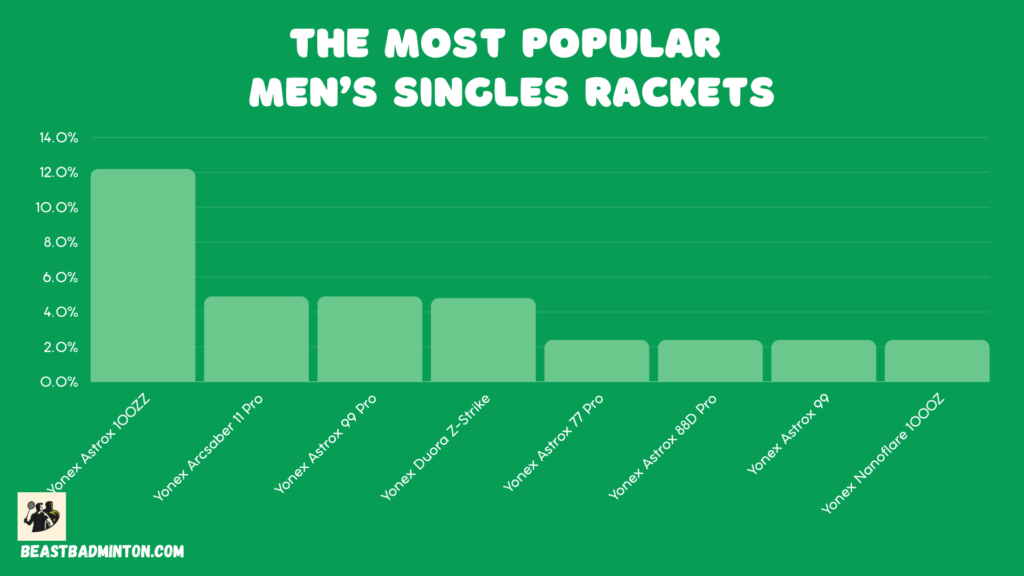
But I didn’t expect that 13% of the men’s doubles players liked it too. Among men’s doubles players, it wasn’t as clear-cut, though, as the Yonex Arcsaber 11 Pro (16%), Astrox 88D Pro (16%), Astrox 88S Pro (13%), and Nanoflare 800 Pro (13%) were popular too. To my surprise, Victor had just one sponsorship, and Li-Ning, two.
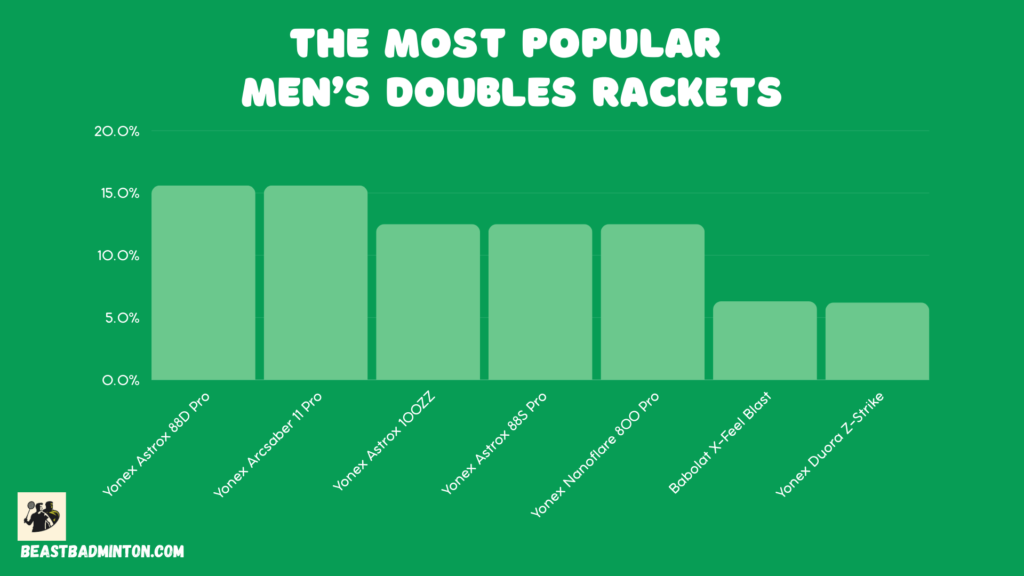
In mixed doubles, the Yonex Astrox 77 Pro, and Yonex’s most lightweight racket among those used by the pros, the Nanoflare 700, were among the most popular rackets making up 13% of the players each.
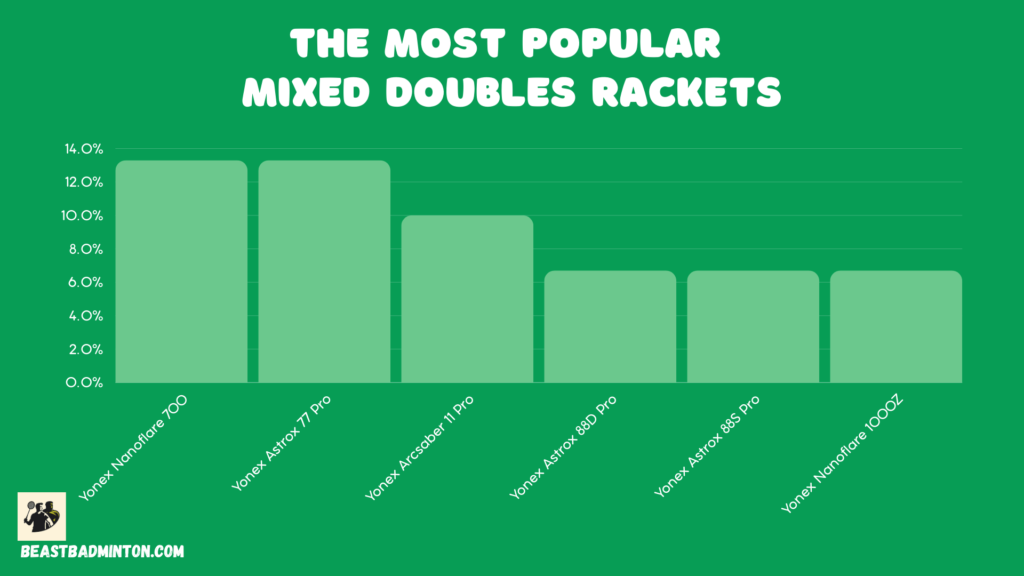
The Nanoflare 700 was the most popular racket used among women’s doubles players, too, with 22% of the players preferring it (followed by the Nanoflare 800 with 13%).
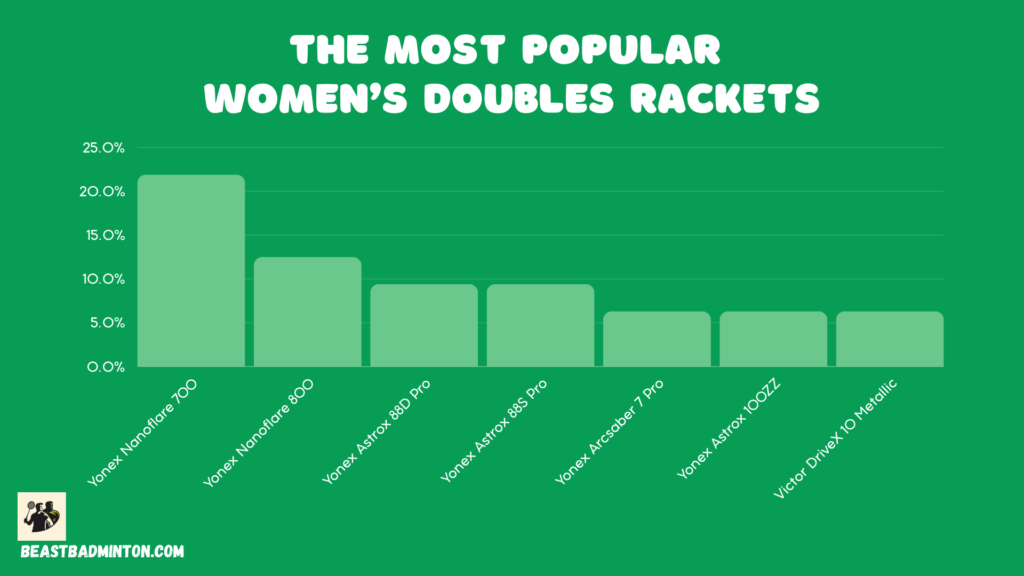
In the women’s singles discipline, the Astrox 77 Pro was popular and used by 13% of the players.
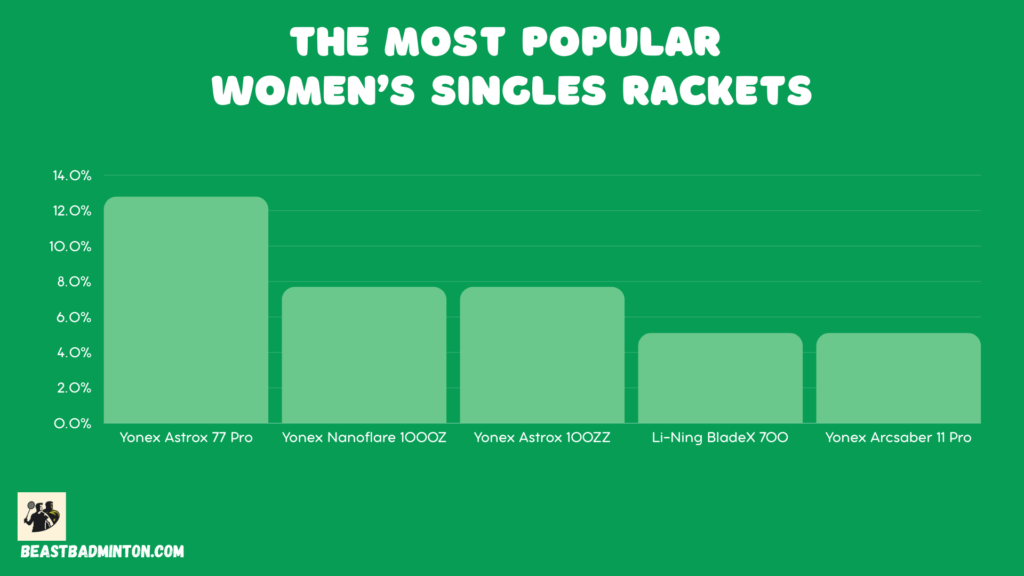
As you’d expect, the singles disciplines tend to lean more towards head-heavy, power-based rackets, whereas the doubles disciplines favor faster rackets.
Badminton 2024 Olympics battle of the brand predictions: which brands will advance from the group stages?
Throughout the process of gathering this data, I got curious about how the group stage draws will stack up if we replace the players and countries with the brands they’re sponsored by in this twist I’m calling the Battle of the Brands.
For simplicity, I’m not considering the skills or seeding of each player and assume that all players (or pairs) have an equal chance of advancing from the group stage. But keep in mind that if a player’s shoe- and racket brand isn’t the same, the racket brand prevails in this case.
Let’s first look at men’s doubles as they are the most skewed. Here, Yonex sponsors 85% of the players with the other brands sponsoring 3-6% of the players so the outcome seems one-sided.
In women’s doubles, the scenario is about the same with Yonex sponsoring 81% of the players with Victor sponsoring 9% and no Li-Ning sponsorships.
In women’s singles, Li-Ning sponsors 13% of the players which is their highest percentage in any of the categories during the 2024 Olympics in Paris (and the highest of any brand besides Yonex in any category).
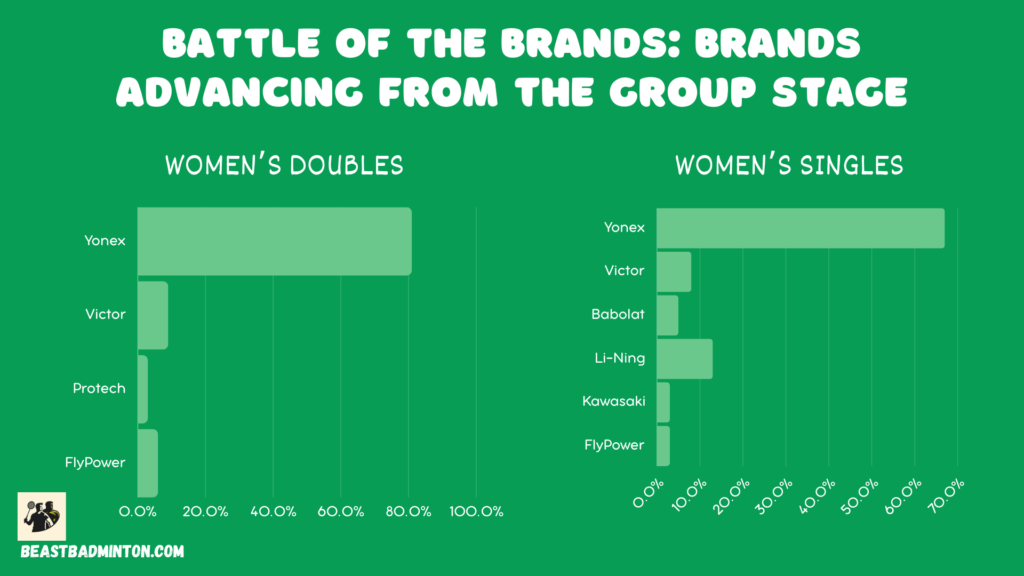
In mixed doubles, however, it’s slightly more even as Yonex ‘only’ sponsors 73% of the players. Li-Ning sponsors 10%, with Victor and Babolat having 7% of the players each, and Mizuno claiming the last 3%.
Yonex covers 67% of the players, with the remaining 20% being split among four other brands.
Surprisingly, men’s singles is the category with the most diversity and Yonex “only” represents 56% of the players, with Victor covering 12% and Li-Ning 10%. The remaining 22% is split among four smaller brands, so this seems like the category where other brands have the highest chance of making it out of the group stage and contesting Yonex during the knockout phase.

Takeaways
I knew Yonex was dominant, but I didn’t realize they were THIS dominant. One reason for that is that many of the usual suspects from the World Tour aren’t competing during the 2024 Olympics in Paris and instead have been replaced with players from less-known nations in the world of badminton.
These players often have limited sponsorships as badminton isn’t big enough in their home country to warrant the big three badminton brands (Yonex, Victor, and Li-Ning) to do a big play leading to a major sponsorship.
I’m under the impression that these players might only get a partial sponsorship (which could explain why they’re playing with different brands for their shoes and racket) or they might not have a sponsor and have to select the gear themselves.
At that point, I imagine they will select the brand based on what’s already popular among other pros, much like we recreational players do, before finding the right shoe and racket model for them within that brand.
If you’re curious if some of the pro gear is for you, I’ve tested many of the popular badminton shoes to give you unbiased reviews along with a few rackets for beginners and intermediate players.